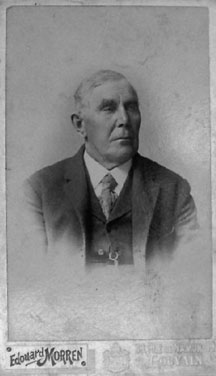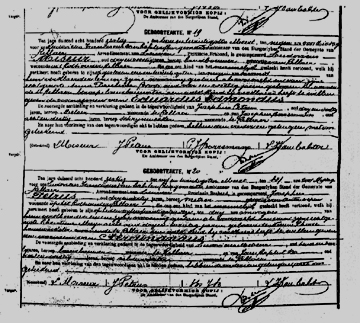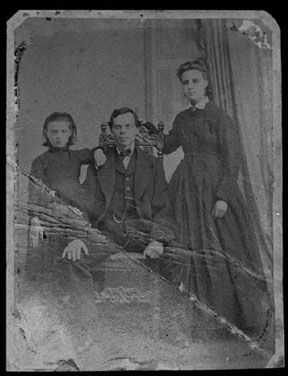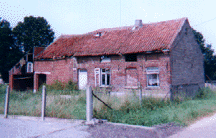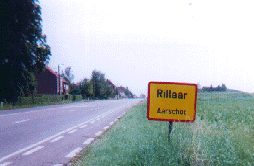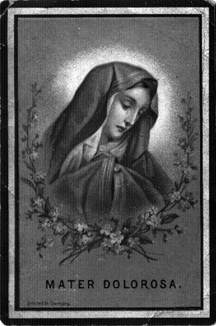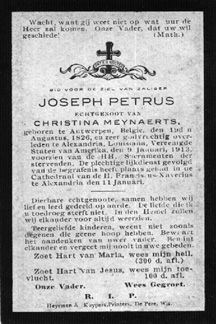Joseph Petrus (photo courtesy of Jan Scholliers).
Joseph Petrus
Joseph Petrus was born in Antwerp Belgium August 19, 1826 (exact day is estimated). Joseph was almost literally "left on the doorstep" of of a Catholic "Vondelinghuis".
"On the marriage certificate (Joseph Petrus to Christina Meynaerts) you can read that Joseph Petrus is found in the slide of the foundling asylum of Antwerp, 21.08.1826. At an estimate, he was two days old then so his birthday had been set at 19.08.1826. 48 hours after he had been found, he was inscribed in the birth registers of Antwerp as a child of unknown parents [as a founding] and received the first name of Joseph and the family-name of Petrus." --- Lucien Meynaerts
Rik Thiels found the following reference to Joseph Petrus's birth and subsequent abandonment in the publication "Vondelingen te Antwerpen van 1796 tot 1860" (Foundlings at Antwerp from 1796 till 1860)
Petrus Josephus, Year 1826, Number 146, Found 21 August 1826, Found at 4:15 am on St. Jorisplace towards the house of the commisioner of the 3rd District, +/- 2 days old. Carried a "mid-picture" and a peice of paper upon which was written "not baptized name Josephus Petrus" Married: At Nieuwrode in 1858 with Mynaerts. Christina.
Rik explains that a "mid-picture" was a piece of paper torn in half to serve as proof of paternity. If a woman wanted to claim her child, she would present the missing piece to prove she was the mother. Joseph's mother apparently never returned to claim Joseph as her own.
I sent the information Rik supplied to Lucien Meynaerts and he offered the following observations.
As you can see at the copy of the attached marriage certificate, the official place where he (Joseph) was found is the slide of the foundling asylum in Antwerp. Nieuwrode has found this data on the asked and gotten "identical copy" of his birth-certificate "real and true" declared and signed by the mayor of Antwerp. Nieuwrode needed that document in order to be able to declare Jozef Petrus civilly married.
That he was found at the Sint-Jorisplein probably comes from the record office for foundlings of the city of Antwerp, now situated in the Lange Gasthuisstraat 33, 2000 Antwerp. It can be true, but I doubt it a lot. Who is going to expose a child in front of the house of the superintendent of police, with the risk to get caught and to have to pay a serious fine, while a few streets further or in the foundling-house they would be able to do this without any problem. The house for foundlings that reported it at the town hall seems not to believe a lot of it itself. It is more likely that the person, who brought the child to the house for foundlings, in order to keep the secret of origin of the child, declared that the child was found at the Sint-Jorisplein.
The fact that the child Joseph Petrus carried along half the image of a saint and a written letter, shows according to me, that the condemnation to the status of foundling was really well prepared by mother and/or her closest family members or with help from others belonging to a better class. Who had, in that time when lots of people were still illiterates, paper, could read and write Latin, knew that the donation of a name was done by the house of foundlings, and that they had to be able to show a proof of property if they would want to take the child back later.
I am more and more convinced that Jozef Petrus was left in the house for foundlings to save the honor of the family, which also explains why he was not asked back later. That would also indicate that Jozef Petrus is biologically coming from a better class of people. The capacities, present with his children and grandchildren, point at more then average intelligence or...would the qualities of the Meynaerts family be inherited? Who shall tell? -- Lucien Meynaerts.
Lucien explains that foundlings were fairly common at that time. Some women were forced to give up a child due to poverty, some because the children were born out of wedlock. Others may have been victims of rape. The problem was common enough that the cities were forced to deal with it.
"Every large city had a fondling-house with a slide, attainable from the street and where, anonymously, a baby could be put in. When the child cried or by inspection of the slide, it was found and then further taken care of." --- Lucien Meynaerts
The small opening in the wall next to the arched doorway is the "slide" through which Joseph Petrus was placed on August 21, 1826. (Thanks to Lucien Meynaerts for providing the article from which the photo above was taken)
The foundling house, where Joseph was left, no longer exists. According to Luciene, the location is now the site of the Provincial Institute for Tropical Medicine in the Sint-Rochusstraat in Antwerp.
While visiting the cemetery in Rillaar, Belgium in 1993 I saw many headstones with the name "Petrus" inscribed. Upon closer inspection, I realized that the headstones were inscribed with the person's first name at the top of the stone rather than the last name. Petrus or "Peter" is apparently a fairly common first name in Belgium. I found no graves with the surname Petrus in the Rillaar cemetery. -- Keith Petrus
Joseph married Christina Meynaerts on November 24, 1858 in Nieuwrode, Belgium. Together they had 10 children, 8 of which lived to adulthood.
Ferdinand Petrus
Polina "Pauline" Petrus
Ludovicus "Louis" Petrus
Jan Benedict Petrus (died at birth or as a child)
Justina Petrus
Maria Rosalia "Rose" Petrus
Alphonse Petrus
Leopold Petrus (died at birth or as a child)
Constant Petrus
Augustus "Gustave" Petrus
|Wedding Certificate
Joseph Petrus and Christina Meynaerts
Transcribed text of actual document by Jan Scholliers. Today, the 24th of November 1858, at 11 am, appeared before us, J.L. Claes, mayor and the one in charge of weddings etc…, of Nieuwrhode, county of Louvain, Province of Braband, in public audience, M. Josephus Petrus, Mason, living in Rillaer, foundling in Antwerp in the slide of the foundling asylum the 21st of august 1826, guessing to be 2 days old, son of unknown parents, and who complied with the regulations on military service, (1) stated by the document added to this certificate, and Christina Meynaerts, Farmer, living in Nieuwrhode and born there the 19th of September 1836, adult daughter of Andreas Meynaerts, deceased at Nieuwrhode the 29th of august 1854, and of Anna Claes, farmer, living at Nieuwrhode, being present here and consenting at the marriage (2) Those who appeared demand us to go on with the ceremony of the marriage that they had planned and which was announced at the principal entrance of our city hall on Sunday 14th and Sunday 21st of November 1858 (3) and at the same moments at Rillaer, each time at 10 am. As nobody mentioned any contra-indications to this marriage, and proceeding as by law, after reading the documents and the 6th chapter of the civil code, title ‘About Marriage’, we have asked the future groom and bride if they wanted to accept each other as man and wife. As each answered ‘yes’, we declared, in the name of the law (4), Josephus Petrus and Christina Meynaerts united in marriage. Of all this we made this certificate in the presence of G. Vermeyen, age 74, of A. Janssens, age 50, both farmers and G.E. Vandermeijen, age 33.(1). This does not necessarily mean that Joseph had served in the army, but probably yes… (2). At the age 22, but not yet 26, Christina still needed the consent of her mother, although she was an adult. This existed until in the 1970's. (3). This means they married on a Wednesday! (4). Religious marriage is only possible after being married by the law. -- Jan Scholliers, Feb 26, 2003.
Two photos of Joseph Petrus and unidentified woman and child - possibly his wife Christina and his eldest daughter Paulina. (photo courtesy of Jan Scholliers).
Jan Scholliers provided the photos above and offers his thoughts on the identies of the woman and child:
My mother was inclined to think that the females were Joseph's daughters. By adding contrast and using extreme magnification on the screen I think it is possible that it is Joseph's wife Christina and their daughter Paulina. That would explain why this picture was in the possession of Paulina. As the child seems to be 8 or 9 years old the picture would be taken approx.. in the year 1870 (Paulina born dec. 24, 1862) Joseph is then age 44, his wife age 34.
Lucien Meynaerts describes Joseph's career as a bricklayer and part-time gardener:
J. Petrus supported hs family in Rillaar as a "metser" (bricklayer). He constructed for instance deep brick laid wells for drinking water, he had built or repaired his home in Nopstal-Rillaar, and as every non farmer at that time he must have had one or more pieces of ground, mostly of minor quality, on which he cultivated probably for his own usage only: vegetables, corn (usually rye), potatoes and possibly also some food for cow, goat or sheep. -- Lucien Meynaerts
In 1887, Louis Petrus conveyed the local agricultural conditions to his brother across the sea in America.
It has been dry for a too long time and the harvest suffered very much by that especially on the dryer fields there the oat isn't good and the potatoes were like cooked. When it started to rain 2 days ago on Friday everything became a little normal again and the corn harvest will be good again on different places one is harvesting already. -- Louis Petrus letter to Ferdinand Petrus dated July 17, 1887.
This is believed to be Joseph Petrus's original home near Rillaar Belgium.
(Photo courtesy of Snuffy Hobbs, 1997)In 1999, Lucien Meynaerts and wife Elza, visited Josephs home outside Rillaar (pictured above). He offers the following observations:
On May 26th 1999, Elza and me, Lucien went looking for the ex-house of Petrus-Meynaerts in Nopstal-Rillaar, to be able to lay down that spot on a map for posterity. And we found it.
In comparison with Snuffy's photo of 1997, the house is sharply fallen into disrepair: the roof is gone, the left side is partly collapsed... and this knowing that in its time, in that district, it was one of the most beautiful houses for regular people. It was all made of stone, while in that time, lots of houses, including the one of Christina's brother Francis (born in 1831, my grandfather), were made of wood and loam. Our oldest children still saw it. It is a great pity I did not take any pictures of it.
Father Jozef Petrus probably, as a bricklayer, built his house himself, considered the wishes of mother Christina Meynaerts, and that between 1870 [Rosa was born in Roth-Rillaar] and 1873 when Alfons was born in Nopstal-Rillaar. In that house, also Constant and Gustaaf were born. All the children, also Nand, grew up there and have there gone through a lot together as well inside as outside the house.
It probably has hurt mother Christina in 1891 that she had to leave this house for the USA. There, she probably thought lots of times, being a little homesick, to her comfortable house in Rillaar. She certainly must have done this when in the USA they had to restart from the beginning, and in 1913, when her husband Jozef Petrus died, and she (being 77 years old) stayed behind all alone with all her memories... -- Lucien Meynaerts.
The road to Rillaar. (photo-Snuffy Hobbs, 1997)
Joseph's eldest son, Ferdinand, had immigrated to America in 1881 (according to the 1900 and 1910 census) and no doubt encouraged the rest of the family to follow.
To come to you is something father doesn't like, somewhere he is right, as long as we can make some money here. On the other hand it will be very hard to come to you for old people like them. They don't have that much of work but they are used to live in that modest way. But mother would like to come. She will do so in winter when the evenings are longer. -- Louis Petrus letter to Ferdinand Petrus dated June 10th 1888.
Joseph immigrated to the United States in 1891. The ship's passenger list dated October 12th 1891 gives his age as 67 although his actual age, according to his birth records, would have been 65. His occupation was listed as "farmer." He traveled with his wife Christina whose age was listed as 57 (an apparent error in the passenger list shows "Christina" logged as "Justine") and four children, Alphonse age 17, Rosa age 18, Constant age 13 and Gustaf age 11. The family traveled on the ship "Duepuy de Lome" captained by a Mr. "Dechaille." (Source, Audrey Vandersypen research at LSUA Library, Reel 75, Film # 205.)
Joseph had two daughters "Justien" and "Polina" who were already married and remained behind in Belgium.
Paulinne the oldest daughter married a butcher (Van Opstal) and lived in Leuven, she had 3 children (Gaston, Jules and Mary). Justinne (my mothers mother) was married with A. Couson(sp) and runned a shop (Feed) and had also seven children. --- Bruno Vinck letter to James and Edith Petrus dated February 1, 1984.
Our Belgian cousin, Lucien Meynaerts notes that Pauline actually had at least 5 children.
Polina is doing fine and has a son now and a servant and a maid-servant. They slaughter 6 big porcs every week. -- Louis Petrus letter to Ferdinand Petrus dated July 17, 1887.
Eight years passed before Joseph became an official citizen of the United States of America. Audrey Vandersypen very generously provided me with an original document dated April 20th, 1903 which details the terms of Joseph's naturalization.
Joseph Petrus vs. Naturalization
No. 4264, 10th Judicial District Court
TO THE HON'L THE PRIVILEGES OF THE 10TH JUDICIAL DISTRICT COURT SITTING IN AND FOR RAPIDES PH, LA.-----JUDGMENT-----
This cause coming on for trial according to law and the trial having been regularly had and the law and the evidence being in favor of Joseph Petrus, it is therefore ordered, adjudged and decreed that the said Joseph Petrus be and he is hereby permitted to renounce his allegiance to the King of Belgium and to take the oath of allegiance to the government of the United States of America and to be upon his taking his said oath according to law a naturalization citizen of the U.S. as a naturalized citizen thereof. This done, read and signed in open court this 13th day of November A.D. 1899
E.G. Hunter, Judge 10th Judicial District Court.
State of Louisiana, Parish of Rapides.The 1900 census gives Joseph's occupation as "farmer" and living with wife Christina and sons Constant and Gustave. The census records the correct birthdate of Joseph in August of 1826 making him 73 years old at the turn of the century. Christina's birthdate is recorded as September 1836 (age 64), Constant November 1876 (age 23) and Gustave Feb 1879 (age 20). Christina is recorded as the mother of 12 children, eight of which were still living at the time. (Lucien Meynaerts points out that Christina had only 10 known children so it is likely this is in error). It also correctly records Joseph's immigration date of 1891 and that he had lived in the U.S for 8 years.
In 1903 Joseph travelled to Belgium. Rik Thiels supplied the following information from the publication "Belgische Emigranten Naar Amerika" (Belgian Emigrants to America) 1903-1904.
Petrus Joseph, 77 years, from Antwerp. Gardner returns to Alexandria (Louisiana) where he is settled since 12 years as a gardner. American naturalized. Takes along 200 FR., speaks Flemish.
In 1908, Josephs son Gustave reports on the condition of his father and mother in a letter to Ferdinand Petrus.
Father and Mother are still living in town and are both in good condition. Mother goes every day to the (?) and Father still has his garden to give him something to do. Sometimes both of them stroll on over our way. -- Gustave Petrus letter to Ferdinand Petrus dated May 31, 1908
Catholic death notice for Joseph Petrus (in Dutch/Flemish).
Joseph died January 19th, 1913 in Alexandria, Louisiana at the age of 86. The details of his death were recorded in a letter written by Joseph's son, Louis Petrus.
"Dear brother, Father has died on January 9th at 12 o'clock in the night. Carrying out of the holy sacraments and burial on Saturday the 11th. Pray for his soul that He who created us may give him quickly the kingdom of heaven. On the evening of Saturday the fourth he fell from the ditch and broke his collarbone and suffered internal injuries and had and attack of pleurisy. His suffering was very great. And I hope the Lord will give to him eternal life." --- Louis Petrus letter to Ferdinand Petrus dated January 17, 1913.
The Pineville "Rapides Cemetery" where Joseph Petrus is buried is located on the other side of this bridge across the Red River. Most cemeteries are located in Pineville, north of the Red River due to it's higher elevation. According to Edith Petrus, the locals have a saying "You may live in Alexandria but you'll always end up in Pineville."
Josephs gravestone in the Pineville Louisiana Cemetery.
Special thanks to Lucien Meynaerts & Snuffy Hobbs for providing information about Joseph Petrus and his life in Belgium. Thanks also to Audrey Vandersypen for providing a copy of Joseph's naturalization decree and passenger list.
Email comments to: keith@enginedesign.com
